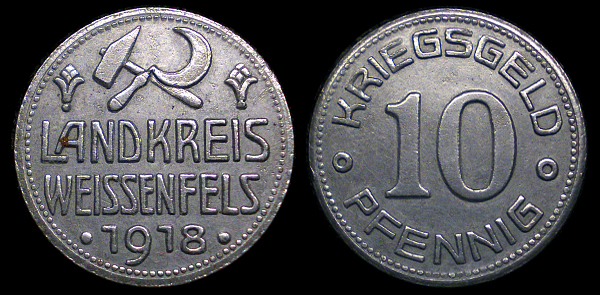
WEISSENFELS (GERMAN) 10 PFENNIG 1918
F- 589.1 District (Landkreis) of Weissenfels (Sachsen) Zinc 10 Pfennig Coin Depicting Hammer and Sickle.
This iron coin depicting a hammer and sickle was issued by the District (Landkreis) of Weissenfels and was meant to be used as small change. It bears the word 'Kriegsgeld' which denotes it as war money. The district seat was the town of Weissenfels which received municipal rights in 1185. The town served as the capitol of the Duchy of Saxe-Weissenfels which was part of the Holy Roman Empire. It was ruled by the cadet branch of the House of Wettin until that family line ended and it was passed to the Duchy of Saxony in 1746. Saxony would later become a Kingdom and a part of the German Empire.
When this coin was minted, Weissenfels was a district in what was the Province of Saxony, a part of the Free State of Prussia. The Prussian free state was formed in the same year from what was left of the Kingdom of Prussia after the dissolution of the German Empire in 1918.
As early as the mid-19th century Saxony, and its largely working class population, became home to social reformers looking to protect the rights of the workers who were, in essence, serfs ruled by wealthy landlords. During the war and after the defeat of the German Empire in World War I, The kingdom had a sizable population of Socialists, Democrats, Anarchists, reformers, radicals, and Communists (as evidenced by the imagery on this coin). Many of these people were pleased to see the dissolution of the Empire and the forced abdication of its Royalty. When the German Republic was proclaimed in 1918, Friedrich August III, King of Saxony was asked by telephone whether he would abdicate willingly. With a bit of humor he answered "Oh, well, I suppose I'd better." On November 13th, his reign came to an end and Saxony became a Province within the new Free State of Prussia, administered by a a variety of coalition governments.
Saxony and its districts, including Weissenfels, saw political turmoil and social upheaval leading to the German Revolution and the creation of the Weimar Republic in 1919. Its official name was still Deutsches Reich but it was actually a parliamentary republic commonly referred to as Weimar, the place where the constitutional assembly took place. The Weimar Republic was burdened with strains on its fragile post war economy as well as social, political and ideological factionalism.
When French and Belgium troops occupied the Ruhr Area in January 1923, the workers of Saxony complied with the passive resistance. During this resistance workers did not produce but were still paid. The loss of production led to shortages and the additional strain on the economy resulted in hyperinflation and eventual economic collapse.
After the institution of the Dawes plan which called for restructuring and economic recovery with the help of allied nations, political factionalism intensified. As the Nationalists gained influence and power, competing political parties were eventually dismantled and their leaders often disappeared. Socialists, democrats and communists often paid for their outspoken believes and often suffered the same fate of the Jews under the new German Reich. Saxony was merged with the Free State of Anhalt to become the the new state of Saxony-Anhalt. After World War II, Saxony-Anhalt was occupied by Russian forces and Weissenfels became a part of the new Socialist German Democratic Republic (GDR) often referred to as East Germany. During this time, Saxony-Anhalt was divided into the East German districts of Halle and Magdeburg. Although East Germany was granted full sovereignty in 1955, Russian troops remained. East Germany was a member of the Warsaw Pact and remained a close ally of the USSR.
Today Weissenfels is a part of the federal state of Saxony-Anhalt reformed after German unification. As a result of recent reorganization, the number of districts were decreased from 21 to 11 and Weissenfels ceased to be a district becoming a part of neighboring Burgenlandkreis. Weissenfels, the town, is now the largest in Burgenlandkreis and remains an administrative body for the surrounding rural areas.
